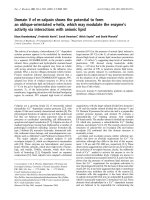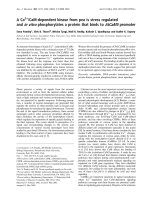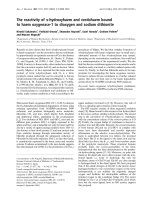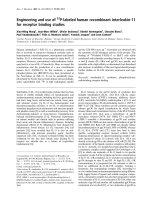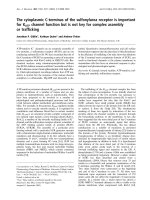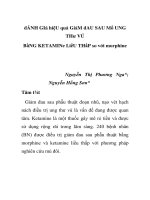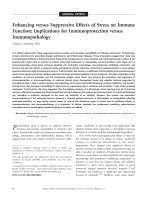Báo cáo y học: "Pro/con ethics debate: Should mechanical ventilation be continued to allow for progression to brain death so that organs can be donated" pdf
Bạn đang xem bản rút gọn của tài liệu. Xem và tải ngay bản đầy đủ của tài liệu tại đây (40.17 KB, 4 trang )
ICU = intensive care unit; PVS = persistent vegetative state.
Available online />The patient is a previously healthy 17-year-old boy who was
transferred by air ambulance from a regional community
hospital after nearly drowning. During a boat ride in a lake,
the boy fell out of the boat and became entangled and
submerged under water for an undetermined period of time.
The boy was pulled to shore, where cardiopulmonary
resuscitation was begun immediately because of absent vital
signs. The boy was brought to the community hospital after
cardiorespiratory arrest for approximately 20–30 min. Vital
signs were absent when the patient arrived. The patient was
given one round of resuscitation medications, after which a
heart rate and cardiac output were restored. The patient was
transferred to a tertiary care paediatric hospital.
On arrival at the referral hospital, the patient had no
spontaneous movements, no motor response to pain, fixed
and dilated pupils, and absent corneal, gag and cough
reflexes. Spontaneous respiratory efforts were detected.
There was a delay in the arrival of family members who were
out of country at the time. After 24 hours of mechanical
support, his neurological condition was unchanged.
Given the severity of hypoxic ischaemic brain injury and the
patient’s dismal prognosis, the family was counselled to
withdraw mechanical support. They requested organ donation
but were informed that he was not eligible as he did not fulfil
brain death criteria in view of the presence of spontaneous
respiratory efforts. They agreed to withdrawal of support. The
patient died 10 min after withdrawal of mechanical ventilation.
Questions
The outcome after out-of-hospital cardiac arrest in children
and adults is well known. Did the present child justify
intensive care unit admission and why?
Twenty-four hours after admission to the intensive care unit
(ICU), the family of this teenager requested organ donation.
When the patient has expressed a prior wish or families are
motivated toward organ donation, is there an option to
continue mechanical ventilation for 24–48 hours to observe
for progression to brain death in anticipation of organ
donation? What are the risks and benefits associated with
this option? What are the ethical issues raised by this?
Commentary
Pro/con ethics debate: Should mechanical ventilation be
continued to allow for progression to brain death so that organs
can be donated?
Michael Parker
1
and Sam D Shemie
2
1
University Lecturer in Medical Ethics, The Ethox Centre, University of Oxford, UK
2
Department of Critical Care Medicine, Hospital for Sick Children, University of Toronto, and Montreal Children’s Hospital, McGill University, Canada
Correspondence: Critical Care Editorial Office,
Published online: 15 August 2002 Critical Care 2002, 6:399-402
This article is online at />© 2002 BioMed Central Ltd (Print ISSN 1364-8535; Online ISSN 1466-609X)
Abstract
Organ transplants continue to redefine medical frontiers. Unfortunately, current demand for organs far
surpasses availability, waiting lists are long and many people die before the organ they desperately
need becomes available. One proposed way to increase organ availability is to admit patients to the
ICU with severe neurological injuries, for a trial of therapy. If the injury is irretrievable, discussions would
then focus on extending ventilation for potential brain death/organ donation if a prior wish to donate is
known or if the substitute decision maker consents. The following debate discusses the ethical
dilemmas of waiting for brain death.
Keywords brain death, ethics, organ procurement, transplant
The scenario
Critical Care October 2002 Vol 6 No 5 Parker and Shemie
Con: no, mechanical ventilation should not be continued to allow for progression to brain
death so that organs can be donated
Michael Parker
The number of organs available for transplantation falls well
below the number of people who require a transplant [1]. In
the United Kingdom, for example, there were 5354 people on
the national transplant waiting list at the end of March 2000
[2]. In practice, because of the recognized shortage of
available organs, patients are only placed on this waiting list if
they have a reasonable chance of receiving a donated organ.
This means that the actual number of those who could
benefit from a transplant is much greater than the number of
people on the list.
A range of different ways has been proposed for increasing
the number of donors. One of the most controversial of these
is the use of ‘elective ventilation’ of patients in deep coma
and close to death who have no possibility of recovering but
do not (yet) fulfill the criteria for brain death [3]. In elective
ventilation, patients are ventilated for a few hours to allow
preparations for the removal of organs after death to take
place. There is evidence that this could increase the number
of available organs significantly. The practice was used in
Exeter, UK between 1988 and 1994 (when it was declared
unlawful), and led to a 50% increase in the number of organs
suitable for transplantation there [4]. The case described in
the present scenario is an example of the kind of situation in
which elective ventilation might make available organs that
would otherwise be lost.
One way of analysing the ethical implications of elective
ventilation is to consider the foreseeable harms and benefits
of its use. It might seem from this consequentialist
perspective, initially at least, that emphasis ought to be
placed on increasing the number of organs available for
transplant. A more complete consequentialist analysis would
of course have to consider other possible harms and
benefits. One potential harm that is surely going to be
relevant to any such analysis is the small possibility that,
rather than dying following elective ventilation, patients may
end up in a persistent vegetative state (PVS) [5]. The
chances of this happening are small, but from the point of
view of a consideration of the patient’s best interests it is not
only be the size of the risk that will be of importance, but also
its seriousness.
Another set of factors important in any consequentialist
account will concern the opportunity costs of elective
ventilation. In the case presently described, the procedure
will require an intensive therapy unit bed for up to 2 days. The
question of whether this bed, or the equivalent resource
spent elsewhere, would save more lives is surely important
and not easy to answer without a full consideration of the
health economic implications.
The most common objection to the use of elective
ventilation is not consequentialist, however, but based in
respect for patient autonomy. Elective ventilation involves
carrying out an invasive procedure on a living patient to
which the patient has not consented. Furthermore,
ventilation is not being carried out in the interest of the
patient. The only purpose of the intervention is to provide
organs for others and this is, in effect, treating patients
merely as a means for the benefit of others and not as ends
in their own right.
One possible way of dealing with this objection would be to
argue that there are grounds to believe that this is what the
patient would have wanted. This is an argument often used
by those in favour of a presumed consent model for
transplantation. In the case of the patient who is brain dead,
this argument has at least some force. A recent poll in
Scotland, for example, found that a slight majority of those
asked were in favour of a change to presumed consent.
More broadly, opinion polls, in the UK at least, consistently
reveal that around 70% of those asked would want their
organs used on their death [6]. Nevertheless, even if we
were to accept this as a justification for moving to a
presumed consent model for brain death, we would not be
justified in making the same assumption in the case of
elective ventilation.
It is entirely unclear in the case of elective ventilation
whether, if asked whether they would be willing to take the
risk of ending up in PVS in order to provide organs for
others, most or even many people would answer in the
affirmative. Indeed, what evidence there is appears to point
in the opposite direction. Many existing advance directives
posit PVS as one of the states that patients would most
wish to avoid [7]. This is of course an empirical question
requiring further research. Nevertheless, if we are to take
patient autonomy seriously, we should not carry out
invasive procedures on incompetent patients that we do
not consider to be in their best interests without
compelling evidence to believe that this is what they would
have wanted. In the present case, we have no such
evidence.
Whether from a consequentialist perspective or one based in
the principle of respect for patient autonomy, any move to the
use of elective ventilation must be based in both good
empirical and health economic analysis and in informed
public debate. In the meantime, what evidence there is would
seem to point in the direction of caution and would indicate
that, in the case under consideration, ventilation should not
be allowed to proceed.
Available online />Pro: yes, mechanical ventilation should be continued to allow for progression to brain death so
that organs can be donated
Sam D Shemie
Is it medically appropriate and/or ethical to extend ventilation in
anticipation of brain death for the purposes of organ donation?
To clarify the challenges presented by this case, each of the
following issues must be discussed individually: admission of
severely brain-injured patients to the ICU, extension of
ventilation, anticipation of brain death, and brain death for the
purposes of organ donation.
Admission of severely brain-injured patients to the ICU
The decision to admit severely brain-injured patients to the ICU
is complex and is influenced by many factors. Severity of injury
and potential for salvage are clearly dominant factors.
Distinguished from adult practice, acutely brain-injured
paediatric patients are rarely denied admission on the grounds
of poor neurological prognosis. Paediatric death outside ICUs
is an unusual event, with 85% of deaths at the Hospital for
Sick Children occurring in the ICU setting (S Shemie,
unpublished data). In general, practitioners outside the ICU are
not comfortable with paediatric death, with grounds for
prognosticating, and with withdrawal of established
mechanical ventilation. A trial of ICU therapy is initiated to
collect and confirm the facts upon which prognostications are
based and to allow families time to adjust and be counselled.
Severely brain-injured adults with artificial ventilation already
established, in contrast, may be evaluated in the emergency
room and, based on the perception of bad prognosis, be
denied access to ICU services. Although based in large part
on a poor anticipated prognosis, resource limitations (lack of
available ICU nurses/bed space) must be acknowledged as a
profound influence on these triage decisions.
Studies predicting neurological outcome after cardiac arrest
suggest that the most reliable predictors are apparent in the
range of 24 hours [8] to 72 hours [9] after arrest. One can
credibly advocate that a short-term trial of ICU therapy is
warranted in any acutely brain-injured patients in order to
confirm facts to avoid expedited decisions that occur in
emergency rooms. In addition, there are evolving
neuroprotective therapies that may benefit patients which
traditionally have been perceived to have irretrievable
outcomes. This is well supported by the improvements in
neurological outcome with the use of hypothermia after
cardiac arrest [10]. In the face of advancing techniques of
successful neuroprotection, there is concern for the potential
self-fulfilling prophecy of the selecting out of severely brain-
injured patients by preventing access to ICU care.
Extension of ventilation
Limitation of life-sustaining technology has become standard
practice for ICU-based end-of-life care, with the majority of
deaths in neonatal, paediatric and adult ICUs being
preceded by the withdrawal and/or withholding of some form
of life support [11,12]. However, there are inconsistencies in
these practices with variation over time, between centres and
between clinicians [13]. The criteria for what may be
considered futile therapy remains undefined and, for the
same acuity of illness, withdrawal practices may vary [14].
Observers of end-of-life discussions in ICUs have concluded
that although life support technologies are traditionally
deployed to treat morbidity and to delay mortality in ICU
patients, they are also used to orchestrate dying. The tempo
of withdrawal influences the method and timing of death.
Decisions to withhold, to provide, to continue or to withdraw
life support are socially negotiated to synchronize
understanding and expectations among family members and
clinicians [15].
Ethical principles dictate that we must act in the interests of
the patient first and foremost. In the complex realities of
bedside ICU care, however, life support is manipulated in
many ways that are not strictly in the primary interest of the
patient. This is seen during the family’s (or subspecialist’s)
adjustment phase of understanding the disease and
accepting the terminal phase of illness; this communication
process may take days to weeks, and sometimes months.
There may be conflict or disagreement with the
recommendations of the ICU team, resulting in prolongation
of life support. This may be under the guise of acting in the
interest of the patient but is, in reality, acting in the emotional
interests of the family. There are compassionate reasons to
extend ventilation; waiting for extended family to arrive from
overseas, or not to have the patient die on a special day (e.g.
Christmas or a birthday). It is often difficult to separate the
interests of the family from the interests of the patient, and
this reality is exaggerated in the paediatric sphere.
Can one ethically justify extension of ventilation? Certainly,
there is clinical precedence for this practice, many reports of
which are aforementioned. A majority of Canadian paediatric
intensivists are in favour of extending ventilation for organ
donation. For example, in response to the survey question ‘in
the setting of acute brain injury, would you extend the
duration of life support for brain death to potentially occur’,
68% of respondents said yes, 21% were unsure and only
11% of respondents said no [16].
The issue at stake here, however, is the patient’s interest. Is it
being compromised by the extension of ventilation? Is it
beneficial, harmful or neither? Suffering is an exaggerated
concept in comatose ICU patients who have lost
Critical Care October 2002 Vol 6 No 5 Parker and Shemie
consciousness. Whether they spiritually suffer or their dignity
is compromised is at best subjective and uncertain. The issue
of benefit versus harm rests between the benefit of
actualizing the donation of organs from an individual or family
who have expressed this intent and the harm of extending
ventilation.
Anticipation of brain death
Neurological prognosis after devastating brain injury is able
to distinguish between extremes of outcomes. Prognostic
criteria for outcomes after cardiac arrest, particularly those
presenting with asystole to the emergency room, have been
well defined in paediatrics [17] and in adults [8]. Bad
outcome, however, is defined as death or vegetative survival,
and there has been no clear predictive data that
distinguishes between brain death and vegetative survival
[18]. Clearly, any intervention that may convert a patient
destined to die after withdrawal of ventilation into a
vegetative survivor is concerning. This has been anecdotally
cited by ICU practitioners as the primary issue of concern
regarding the extension of ventilation in severely brain-injured
ICU patients.
Experience in clinical ICU practice dictates some guidelines
where the risks of extending ventilation are minimized. The
temporal changes in neurological function after brain injury
give information about its anticipated evolution. A
deteriorating neurological course may be anticipated if the
signs of neurological function (motor score, brain stem
reflexes) are deteriorating over time. A comatose patient who
decorticates to pain on admission to ICU with intact brain
stem reflexes may proceed to lose any motor response to
pain, followed by gradual loss of brainstem reflexes (e.g.
unilateral fixed and dilated pupil) over the ensuing 24 hours.
This scenario may increase the chance of proceeding to
brain death, and minimizes the risk that extending ventilation
would allow recovery of vegetative brainstem function.
Conversely, a patient may present with a Glasgow Coma
Scale of 3, with no response to deep pain on arrival at the
ICU, and then at 24–48 hours may develop decerebrate
posturing. This scenario reflects an evolving improvement in
neurological function. It is not one where extension of
ventilation is safe and may increase the chances of vegetative
survival.
Brain death for the purposes of organ donation
There remains a perception that extending ventilation to allow
for brain death for the purposes of organ donation is an act
against the interests of the patient. It may in fact serve the
interest of the patient if the expressed wishes were known
and the risks are small. Consent decisions are primarily
influenced by prior knowledge of the deceased individual’s
wishes [19]. It is well established that the act of organ
donation aids in the grieving process for family members
[20]. Donation decisions are a function of attitude toward
donation and the religious, cultural, altruistic, normative, and
knowledge-based beliefs that comprise the attitude. For the
individual expressing intent to donate, there is actual and
spiritual sustenance that is derived from the decision to give.
If the surrogate decision makers are aware of the patient’s to
wish to donate, it may be in the patient’s interest to pursue
any reasonable avenue to fulfil the desire to donate.
References
1. British Medical Association: Organ Donation in the 21
st
Century:
Time for a Consolidated Approach. London: British Medical Asso-
ciation; 2000:2-6.
2. UK Transplant Support Services Authority: Transplant Update.
Bristol: UK Transplant Support Service Authority; March 2000.
3. Fabre J: Elective ventilation of potential organ donors [letter].
BMJ 1995, 311:950.
4. NHS Executive: Identification of Potential Donors of Organs for
Transplantation, HSG(94)41. London: NHE Executive; 10
October 1994.
5. New B, Solomon M, Dingwall R, McHale J: A Question of Give
and Take: Improving the Supply of Donor Organs for Transplan-
tation. London: King’s Fund Institute; 1994.
6. British Medical Association: Organ Donation in the 21
st
Century:
Time for a Consolidated Approach. London: British Medical Asso-
ciation; 2000:4, 17.
7. Emanuel LL, Emanuel EJ: The Medical Directive: a new compre-
hensive advance care document. JAMA 1989, 261:3288-3293.
8. Levy DE, Caronna JJ, Singer BH, Lapinski RH, Frydman H, Plum F:
Predicting outcome from hypoxic-ischemic coma. JAMA 1985,
253:1420-1426.
9. Edgren E, Hedstrand U, Kelsey S, Sutton-Tyrrell K, Safar P: Assess-
ment of neurological prognosis in comatose survivors of cardiac
arrest. BRCT I Study Group. Lancet 1994, 343:1055-1059.
10. Bernard SA, Gray TW, Buist MD, Jones BM, Silvester W, Gut-
teridge G, Smith K: Treatment of comatose survivors of out-of-
hospital cardiac arrest with induced hypothermia. N Engl J
Med 2002, 346:557-563.
11. Prendergast TJ, Luce JM: Increasing incidence of withholding
and withdrawal of life support from the critically ill. Am J
Respir Crit Care Med 1997, 1:15-20.
12. Keenan SP, Busche KD, Chen LM, McCarthy L, Inman KJ, Sibbald
WJ: A retrospective review of a large cohort of patients under-
going the process of withholding or withdrawal of life support.
Crit Care Med 1997, 8:1324-1331.
13. Prendergast TJ, Claessens MT, Luce JM: A national survey of
end-of-life care for critically ill patients. Am J Respir Crit Care
Med 1998, 8:1163-1167.
14. McLean RF, Tarshis J, Mazer CD, Szalai JP: Death in two Cana-
dian intensive care units: institutional difference and changes
over time. Crit Care Med 2000, 1:100-103.
15. Cook DJ, Giacomini M, Johnson N, Willms D: Life support in the
intensive care unit: a qualitative investigation of technological
purposes. Canadian Critical Care Trials Group. CMAJ 1999,
161:1109-1113.
16. Shemie SD, Cupido CM: The management of brain death and
organ donation in Canadian children [abstract]. Pediatr Crit
Care Med 2000, 1:A46.
17. Schindler MB, Bohn D, Cox PN, McCrindle BW, Jarvis A, Edmonds
J, Barker G: Outcome of out-of-hospital cardiac or respiratory
arrest in children. N Engl J Med 1996, 335:1473-1479.
18. Shewmon DA: The probability of inevitability: the inherent
impossibility of validating criteria for brain death or ‘irre-
versibility’ through clinical studies. Stat Med 1987, 6:535-553.
19. Radecki CM, Jaccard J: Psychological aspects of organ dona-
tion: a critical review and synthesis of individual and next-of-
kin donation decisions [review]. Health Psychol 1997, 16:
183-195.
20. Pearson IY, Bazeley P, Spencer-Plane T, Chapman JR, Robertson
P: A survey of families of brain dead patients: their experi-
ences, attitudes to organ donation and transplantation.
Anaesth Intensive Care 1995, 23:88-95.

